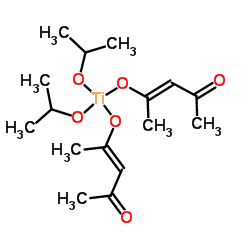Titanium diisopropoxide bis(acetylacetonate)

Titanium diisopropoxide bis(acetylacetonate) structure
|
Common Name | Titanium diisopropoxide bis(acetylacetonate) | ||
|---|---|---|---|---|
| CAS Number | 17927-72-9 | Molecular Weight | 364.257 | |
| Density | 1.013 | Boiling Point | 85ºC | |
| Molecular Formula | C16H28O6Ti | Melting Point | N/A | |
| MSDS | Chinese USA | Flash Point | 85ºC | |
| Symbol |


GHS02, GHS07 |
Signal Word | Danger | |
|
Effect of double blocking layers at TiO2/Sb2S3 and Sb2S3/spiro-MeOTAD interfaces on photovoltaic performance.
Faraday Discuss. 176 , 287-99, (2015) The effect of double blocking layers on the Sb(2)S(3)-sensitized all solid state solar cell are investigated. Thin layers of ZrO(2) (blocking layer 1, BL1) and ZnS (blocking layer 2, BL2) are introduced at the TiO(2)/Sb(2)S(3) and Sb(2)S(3)/hole transporting ... |
|
|
Enhancement of the photovoltaic performance of CH₃NH₃PbI₃ perovskite solar cells through a dichlorobenzene-functionalized hole-transporting material.
ChemPhysChem 15(12) , 2595-603, (2014) A dichlorobenzene-functionalized hole-transporting material (HTM) is developed for a CH3NH3PbI3-based perovskite solar cell. Notwithstanding the similarity of the frontier molecular orbital energy levels, optical properties, and hole mobility between the func... |
|
|
High-efficiency perovskite solar cells based on the black polymorph of HC(NH2)2 PbI3.
Adv. Mater. 26(29) , 4991-8, (2014) Perovskite solar cells with power conversion efficiencies exceeding 16% at AM 1.5 G one sun illumination are developed using the black polymorph of formamidnium lead iodide, HC(NH2)2 PbI3 . Compared with CH3 NH3 PbI3 , HC(NH2 )2 PbI3 extends its absoprtion to... |
|
|
On the Role of Interfaces in Planar-Structured HC(NH2 )2 PbI3 Perovskite Solar Cells.
ChemSusChem 8 , 2414-9, (2015) Planar-structured HC(NH2 )2 PbI3 (FAPbI3 ) perovskite solar cells were prepared via a two-step deposition process. To investigate the role of interface, the perovskite morphology was intentionally modified by varying HC(NH2 )2 I concentration. Surface and gra... |
|
|
Perovskite Solar Cells with Large-Area CVD-Graphene for Tandem Solar Cells.
J. Phys. Chem. Lett. 6 , 2745-50, (2015) Perovskite solar cells with transparent contacts may be used to compensate for thermalization losses of silicon solar cells in tandem devices. This offers a way to outreach stagnating efficiencies. However, perovskite top cells in tandem structures require co... |
|
|
Niobium Doping Effects on TiO2 Mesoscopic Electron Transport Layer-Based Perovskite Solar Cells.
ChemSusChem 8 , 2392-8, (2015) Perovskite solar cells (PSCs) are the most promising candidates as next-generation solar energy conversion systems. To design a highly efficient PSC, understanding electronic properties of mesoporous metal oxides is essential. Herein, we explore the effect of... |
|
|
How Important Is the Organic Part of Lead Halide Perovskite Photovoltaic Cells? Efficient CsPbBr3 Cells.
J. Phys. Chem. Lett. 6 , 2452-6, (2015) Hybrid organic-inorganic lead halide perovskite photovoltaic cells have already surpassed 20% conversion efficiency in the few years that they have been seriously studied. However, many fundamental questions still remain unanswered as to why they are so good.... |